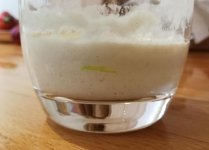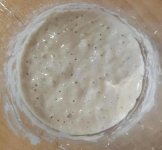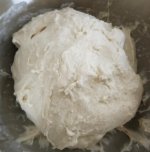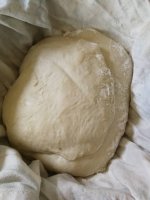Associate
Oh man /salivatesThis is how mine tend to turn out 101038853_672264240284521_8548983960028315648_o.jpg

Oh man /salivatesThis is how mine tend to turn out 101038853_672264240284521_8548983960028315648_o.jpg

Oh man /salivates


I am tomorrow. It's got a good, healthy doubling today.ok, we're just trying to build up the yeast colony. How much starter do you have now then ~60 grams. Are you ready to make bread tonight/tomorrow if it's been fed and it's ready to go?
Great, will do so when I get upIf so take all the starter, add 100 gr each of water and flour and watch it, ideally it will peak at double (or better) after about 5-7 hours as it's a cooler day today if it takes longer then that's fine. As soon as it starts to drop back then make your dough,
No I don't have a recipe, and I don't have a Bannetton either. For bakers-yeast bread I've proofed it in a metal mixing bowl. I have a lidded pyrex casserole dish if that will work? Also have silicone loaf tins.do you have a recipe to use? What do you have to proof it in? a Bannetton?
Those amounts sound good. Does this need kneeding, and how long to I leave it before baking?I'll suggest a nice little 700 gr loaf to start and 65% hydration as that's easy to handle, don't jump right in at high hydration unless you already make lots of bread and can handle wetter doughs with confidence. 350 gr flour, 200 gr starter, 190 gr water and 11 gr salt. Water first into the bowl, add the starter and mix to distributed/break up the starter, add flour with salt last the mix just enough to bring it together. This will leave you with ~ 60gr starter left to continue the process with, the dough has a high proportion of starter too, this can reduce as the starter establishes itself and stabilises.





Are you sure it's mould? In the fridge you'll end up with hooch on top which can have a grey tint. Suggest posting a photo so someone experienced can comment on whether what you're seeing is normal.How do I stop my sourdough starter doing mouldy in the fridge? It seems to last 5-6 days without going mouldy; I'm seeing references on the web for up to 2 weeks in the fridge between feeds for wheat starter.
Definitely sure. Little fluffly islands of white mould floating on a sea of flour paste. No hooch layer, it's all been re-absorbed by day 4. If it happens again this week I'll post a photo.Are you sure it's mould? In the fridge you'll end up with hooch on top which can have a grey tint. Suggest posting a photo so someone experienced can comment on whether what you're seeing is normal.
sounds like there was an excess of flour after feeding/discard, was it well mixed; but, eventually the yeast multiplied and overcame itDefinitely sure. Little fluffly islands of white mould floating on a sea of flour paste. No hooch layer, it's all been re-absorbed by day 4.

